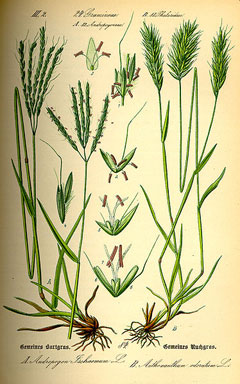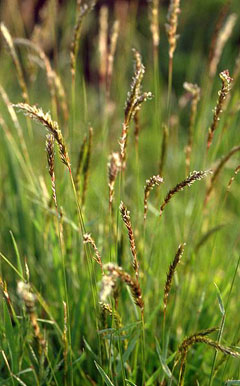 |
|
http://commons.wikimedia.org/wiki/File:Illustration_Anthoxanthum_odoratum0.jpg |
 |
| http://commons.wikimedia.org/wiki/User:Fice |
Translate this page:
Summary
Physical Characteristics

 Anthoxanthum odoratum is a PERENNIAL growing to 0.5 m (1ft 8in) by 0.3 m (1ft).
Anthoxanthum odoratum is a PERENNIAL growing to 0.5 m (1ft 8in) by 0.3 m (1ft).
It is not frost tender. It is in flower from April to June, and the seeds ripen from May to July. The species is hermaphrodite (has both male and female organs) and is pollinated by Wind.
Suitable for: light (sandy), medium (loamy) and heavy (clay) soils. Suitable pH: mildly acid, neutral and basic (mildly alkaline) soils. It cannot grow in the shade. It prefers dry or moist soil.
UK Hardiness Map
US Hardiness Map
Synonyms
Plant Habitats
Woodland Garden Sunny Edge; Meadow; Cultivated Beds;
Edible Uses
Edible Parts: Seed
Edible Uses: Tea
Seed[105, 177]. The seed is very small and its use would be fiddly[K]. A tea is made from the fresh or dried leaves[144]. A sweet pleasant fragrance[183]. Some caution is advised, see notes at top of the page.
References More on Edible Uses
Medicinal Uses
Plants For A Future can not take any responsibility for any adverse effects from the use of plants. Always seek advice from a professional before using a plant medicinally.
Anticoagulant Antiemetic Antispasmodic Stimulant
The whole plant, and especially the flowering stems, is anticoagulant, antispasmodic and stimulant[9, 13]. It is normally only applied externally, where it is used in the treatment of rheumatic pain, chilblains, nervous insomnia etc[9]. It is said that a tincture made from this grass with spirit of wine is an effective and immediate cure for hay fever[4, 240].
References More on Medicinal Uses
The Bookshop: Edible Plant Books
Our Latest books on Perennial Plants For Food Forests and Permaculture Gardens in paperback or digital formats.

Edible Tropical Plants
Food Forest Plants for Hotter Conditions: 250+ Plants For Tropical Food Forests & Permaculture Gardens.
More

Edible Temperate Plants
Plants for Your Food Forest: 500 Plants for Temperate Food Forests & Permaculture Gardens.
More

More Books
PFAF have eight books available in paperback and digital formats. Browse the shop for more information.
Shop Now
Other Uses
Basketry Pot-pourri Strewing
The aromatic leaves and dried flowers are used as a strewing herb, they are also woven into baskets[169, 257] and used in pot-pourri[238]. The plant contains coumarin - this is used medicinally and also in rat poisons where it prevents the blood from co-aggulating and thus means that the slightest cut can kill the rat[13].
Special Uses
Scented Plants
References More on Other Uses
Cultivation details
Succeeds in most soils[200]. Dislikes shade. This is one of the earliest grasses to flower in the year, it produces a lot of pollen and is a major irritant to people who suffer from hay fever[4]. The dried plant releases a strong and persistent fragrance with a refreshing pungent smell that is difficult to describe but is somewhat like newly-mown hay[245].
References Carbon Farming Information and Carbon Sequestration Information
Temperature Converter
Type a value in the Celsius field to convert the value to Fahrenheit:
Fahrenheit:
The PFAF Bookshop
Plants For A Future have a number of books available in paperback and digital form. Book titles include Edible Plants, Edible Perennials, Edible Trees,Edible Shrubs, Woodland Gardening, and Temperate Food Forest Plants. Our new book is Food Forest Plants For Hotter Conditions (Tropical and Sub-Tropical).
Shop Now
Plant Propagation
Seed - sow April in situ, only just covering the seed. The seed usually germinates in 2 - 3 weeks[134]. Division in spring. Very easy, it can be done successfully at almost any time of the year, though it is best to pot up the divisions in a cold frame if you are doing it outside the growing season.
Other Names
If available other names are mentioned here
Native Range
TEMPERATE ASIA: Iran (northwest), Lebanon, Syria, Turkey, Russian Federation-Ciscaucasia (Ciscaucasia), Armenia, Azerbaijan, Georgia, Russian Federation-Western Siberia (Western Siberia), Russian Federation-Eastern Siberia (Eastern Siberia), Kazakhstan, Kyrgyzstan, Mongolia, China (Heilongjiang Sheng, Jilin Sheng, Liaoning Sheng, Xinjiang Uygur Zizhiqu), Japan, Korea, South EUROPE: Denmark, Finland, Faroe Islands, United Kingdom, Ireland, Iceland, Norway, Sweden, Austria, Belgium, Switzerland, Czech Republic, Germany, Hungary, Netherlands, Poland, Slovakia, Russian Federation (European part), Belarus, Estonia, Lithuania, Latvia, Moldova, Russian Federation (Saratov, Volgogradskaja oblast), Ukraine (incl. Krym), Albania, Bulgaria, Bosnia and Herzegovina, Greece (incl. Crete), Croatia, Italy (incl. Sardinia, Sicily), Montenegro, Romania, Serbia, Slovenia, Spain (incl. Baleares), France (incl. Corsica), Portugal AFRICA: Spain (Canarias), Portugal (Madeira Islands), Algeria, Morocco, Tunisia
Weed Potential
Right plant wrong place. We are currently updating this section.
Please note that a plant may be invasive in one area but may not in your area so it's worth checking.
Conservation Status
IUCN Red List of Threatened Plants Status :

Growth: S = slow M = medium F = fast. Soil: L = light (sandy) M = medium H = heavy (clay). pH: A = acid N = neutral B = basic (alkaline). Shade: F = full shade S = semi-shade N = no shade. Moisture: D = dry M = Moist We = wet Wa = water.
Now available:
Food Forest Plants for Mediterranean Conditions
350+ Perennial Plants For Mediterranean and Drier Food Forests and Permaculture Gardens.
[Paperback and eBook]
This is the third in Plants For A Future's series of plant guides for food forests tailored to
specific climate zones. Following volumes on temperate and tropical ecosystems, this book focuses
on species suited to Mediterranean conditions—regions with hot, dry summers and cool, wet winters,
often facing the added challenge of climate change.
Read More
Expert comment
Author
L.
Botanical References
17
Links / References
For a list of references used on this page please go here
Readers comment
| Add a comment |
|
If you have important information about this plant that may help other users please add a comment or link below. Only comments or links that are felt to be directly relevant to a plant will be included. If you think a comment/link or information contained on this page is inaccurate or misleading we would welcome your feedback at [email protected]. If you have questions about a plant please use the Forum on this website as we do not have the resources to answer questions ourselves.
* Please note: the comments by website users are not necessarily those held by PFAF and may give misleading or inaccurate information.
To leave a comment please Register or login here All comments need to be approved so will not appear immediately.
|
Subject : Anthoxanthum odoratum
|
|
|
|